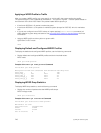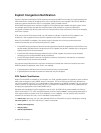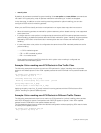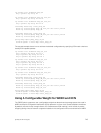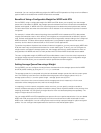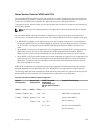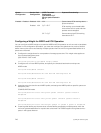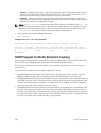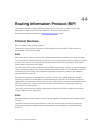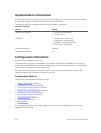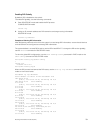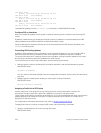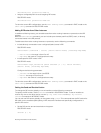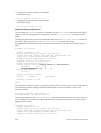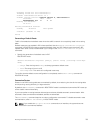
– Allowed — indicates that the policy-map can be applied because the estimated number of CAM
entries is less or equal to the available number of CAM entries. The number of interfaces in the
port-pipe to which the policy-map can be applied is given in parentheses.
– Exception — indicates that the number of CAM entries required to write the policy-map to the
CAM is greater than the number of available CAM entries, and therefore the policy-map cannot be
applied to an interface in the specified port-pipe.
NOTE: The show cam-usage command provides much of the same information as the test cam-
usage command, but whether a policy-map can be successfully applied to an interface cannot be
determined without first measuring how many CAM entries the policy-map would consume; the
test cam-usage command is useful because it provides this measurement.
• Verify that there are enough available CAM entries.
test cam-usage
Example of the test cam-usage Command
Dell# test cam-usage service-policy input pmap_l2 linecard 0 port-set 0
Linecard | Port-pipe | CAM Partition | Available CAM | Estimated CAM | Status
===============================================================================
0 0 L2ACL 500 200
Allowed(2)
SNMP Support for Buffer Statistics Tracking
SNMP support for buffer statistics tracking (BST) counters is implemented in the F10-FPSTATS MIB. BST
counters allow you to better monitor system resources and allocate buffer memory.
BST counters include the Max Use Count statistic, which provides the maximum counter value over a
period of time.
In the F10-FPSTATS MIB, the following tables display BST counters:
• fpEgrQBuffSnapshotTable: Retrieves BST statistics from the egress port used in a buffer. This table
displays a snapshot of the buffer cells used by unicast and multicast data and control queues.
• fpIngPgBuffSnapshotTable: Retrieves BST statistics from the ingress port for the shared and headroom
cells used in a priority group. The snapshot of the ingress shared cells and the ingress headroom cells
used for each priority group are displayed in this table when PFC is enabled. This table is indexed by
stack-unit index, port number and priority-group number.
• fpStatsPerPgTable: Retrieves information on the allocated Min cells, shared cells, and headroom cells
for each priority group, the mode in which the buffer cells are allocated (static or dynamic), and the
used Min cells, shared cells, and headroom cells for each priority group. The table returns a value of 0
if the allocation mode is static and a value of 1 if the allocation mode is dynamic. This table is indexed
by stack-unit number, port number and priority-group number.
748
Quality of Service (QoS)



